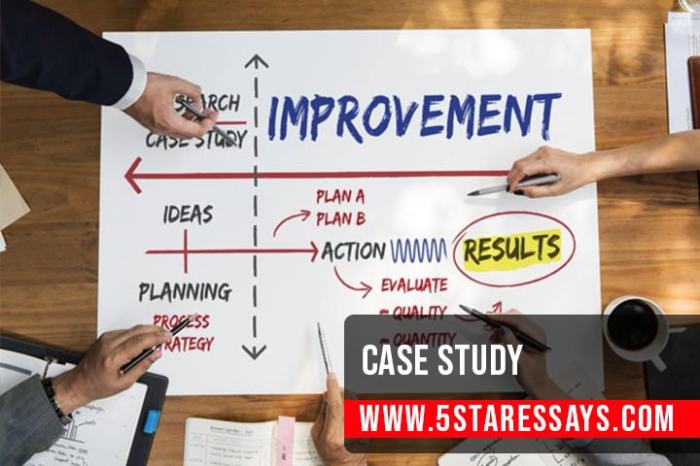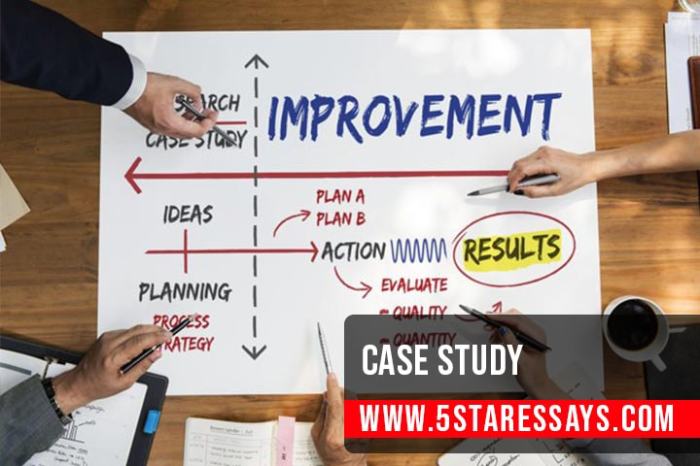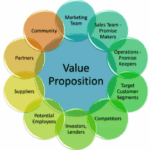Creating a great case study is more than just presenting data; it’s about crafting a compelling narrative that resonates with your audience. This guide dives deep into the essential elements of a successful case study, from defining a captivating problem statement to structuring a logical narrative, presenting compelling data, and ensuring visual appeal. We’ll explore various methods, examples, and templates to help you create case studies that not only inform but also inspire.
This comprehensive guide will equip you with the knowledge and tools to craft impactful case studies across different industries. We’ll cover everything from identifying the key elements of a compelling case study to utilizing effective data presentation and analysis techniques. Furthermore, we’ll explore the importance of visual appeal and engagement, as well as the art of crafting a compelling narrative that captivates your readers.
Defining a Compelling Case Study: Creating A Great Case Study
A compelling case study isn’t just a collection of facts; it’s a story that resonates with the reader, showcasing a problem, its solution, and the tangible results. It’s a powerful tool for demonstrating value and building credibility, influencing decisions and fostering trust. A well-crafted case study effectively communicates the impact of a product or service in a real-world context.A compelling case study goes beyond simply stating the problem and solution.
It delves into the context, demonstrating the depth of understanding and expertise behind the solution. It humanizes the process, allowing the reader to connect with the narrative and see themselves in the client’s shoes. This emotional connection makes the case study more memorable and persuasive.
Characteristics of a Compelling Case Study
A compelling case study possesses specific characteristics that make it impactful and memorable. These include a clear problem statement, a detailed explanation of the solution, and quantifiable results. The narrative should flow logically, engaging the reader from start to finish. A compelling case study is not simply a data dump; it’s a story.
- Clear Problem Statement: A strong case study starts with a concise and compelling problem statement. This clearly defines the challenges faced by the client and sets the stage for understanding the solution’s value proposition. For example, a company might face declining sales due to ineffective marketing strategies. The case study would clearly articulate this problem, providing context and background information.
- Detailed Solution Description: The case study should thoroughly explain the solution implemented, highlighting the specific steps taken and the rationale behind those decisions. It should go beyond a superficial description and provide insights into the methodology employed. For instance, if a new software system was implemented, the case study should detail the selection process, integration challenges, and the training provided to staff.
- Measurable Results: Quantifiable results are crucial to demonstrating the effectiveness of the solution. Metrics such as increased revenue, reduced costs, improved efficiency, or enhanced customer satisfaction should be clearly articulated and supported by data. For instance, a case study about a marketing campaign could show a 25% increase in leads or a 15% boost in sales.
- Compelling Narrative: A strong narrative structure is essential for holding the reader’s attention. The case study should tell a story, highlighting the challenges, the solution, and the positive outcomes. The story should be engaging, relatable, and demonstrate a clear path from problem to solution to results.
Successful Case Study Examples
Numerous successful case studies across various industries demonstrate the power of effective storytelling. A well-crafted case study showcases the tangible benefits of a product or service, thereby influencing purchasing decisions. For instance, a SaaS company can use a case study to illustrate how its platform increased productivity for a client by 20%.
- Software as a Service (SaaS): A SaaS company might demonstrate how their CRM software increased sales by 15% for a mid-sized retailer. They could highlight the specific features used, the training provided, and the measurable results achieved.
- E-commerce: An e-commerce platform could showcase how its customized storefront improved conversion rates by 10% for a fashion brand. The case study could describe the design elements, marketing strategies, and the overall user experience enhancement.
- Marketing Agencies: A marketing agency could present a case study detailing how they increased website traffic by 30% for a tech startup through targeted social media campaigns. Specific campaign strategies and metrics should be included.
Identifying a Compelling Problem Statement
A well-defined problem statement is the cornerstone of a successful case study. It clearly articulates the challenges faced by the client and positions the solution as a viable and effective approach. It should be specific, measurable, achievable, relevant, and time-bound (SMART).
- Specificity: The problem should be clearly defined and not vague. For example, “low website traffic” is vague. A specific problem statement would be “low website traffic resulting in a 20% decrease in sales over the last quarter.”
- Measurability: The problem should be quantifiable. Use data and metrics to demonstrate the impact of the problem.
- Achievability: The solution should be realistically attainable given the resources available.
- Relevance: The problem should be directly related to the solution offered.
- Time-bound: The problem statement should indicate the timeframe within which the problem occurred.
Structuring a Case Study for Reader Interest
The structure of a case study significantly impacts reader engagement. A well-structured case study should guide the reader through the problem, solution, and results in a clear and concise manner.
- Introduction: The introduction should grab the reader’s attention and clearly state the problem faced by the client.
- Background: Provide context and background information on the client and their industry.
- Problem Statement: Clearly define the problem and its impact.
- Solution: Detail the solution implemented, highlighting its key components.
- Results: Present quantifiable results, demonstrating the impact of the solution.
- Conclusion: Summarize the key takeaways and benefits.
Importance of a Clear and Concise Introduction
The introduction of a case study sets the tone for the entire piece. A clear and concise introduction quickly conveys the problem, solution, and desired outcome, immediately capturing the reader’s attention.
- Attention-grabbing Opening: Start with a compelling anecdote, statistic, or question to pique the reader’s interest.
- Problem Definition: Clearly define the problem faced by the client, highlighting its impact.
- Solution Overview: Briefly introduce the solution implemented.
- Expected Outcomes: Briefly Artikel the anticipated outcomes.
Structuring the Case Study Narrative

Crafting a compelling case study involves more than just presenting facts; it’s about weaving a narrative that resonates with the reader and drives home a key takeaway. A well-structured case study clearly Artikels the problem, demonstrates the solution, and highlights the impact. This section delves into the crucial elements of organizing information in a logical sequence, providing templates, and ensuring a cohesive presentation.A well-structured case study isn’t just a collection of data points; it’s a story that illustrates a specific problem, its resolution, and the positive outcomes.
This narrative approach keeps the reader engaged and helps them understand the context and significance of the findings.
Organizing Information Logically
A logical sequence is essential for a compelling case study. Begin by establishing context, then clearly outlining the methodology, presenting the results, and finally, drawing implications and recommendations. This structure ensures a smooth flow of information, allowing the reader to follow the progression of the case and understand the key takeaways.
Background Information
This section sets the stage for the case study. It provides the necessary context and background information to understand the problem and its significance. This includes the historical context, relevant industry trends, and any other factors that contributed to the situation.
- Company Profile: Briefly introduce the company, its mission, and its relevant history. Include key personnel and their roles.
- Problem Statement: Clearly define the issue that the case study addresses. Quantify the problem whenever possible, using metrics and data to show its impact.
- Industry Context: Place the problem within the broader industry landscape. Discuss relevant trends, challenges, and opportunities.
Methodology
The methodology section describes the approach used to conduct the case study. This is crucial for demonstrating the rigor and validity of the findings.
- Research Design: Explain the overall approach to collecting and analyzing data. Was it qualitative, quantitative, or a mixed-methods approach?
- Data Collection: Detail the methods used to gather data, including interviews, surveys, observations, or secondary data analysis. Provide specific examples of the sources used.
- Data Analysis: Explain the techniques used to analyze the collected data. Include specific statistical methods or analytical frameworks employed. Illustrate with examples where possible.
Findings and Results
Present the key findings and results in a clear and concise manner. Use tables, graphs, and charts to visually represent data and support your arguments.
- Key Observations: Summarize the key observations derived from the data analysis. Use clear and concise language.
- Data Visualization: Employ charts, graphs, and tables to illustrate key findings and support your observations. Ensure visualizations are clear and easily understood.
- Quantifiable Results: Present data points, percentages, and metrics to support the findings. For instance, “customer satisfaction increased by 15%.” “Sales increased by 20%.”
Implications and Recommendations
This section discusses the broader implications of the findings and provides actionable recommendations based on the results.
- Impact Analysis: Discuss the broader impact of the findings on the industry, company, or specific stakeholders. Connect the results back to the initial problem statement.
- Recommendations: Offer concrete and actionable recommendations based on the findings. Suggest specific steps that can be taken to improve the situation.
Conclusion
The conclusion summarizes the case study’s key findings and recommendations. It reiterates the significance of the results and their practical application. A well-crafted conclusion leaves a lasting impression on the reader.
- Summary of Findings: Briefly reiterate the main findings of the case study. Use a concise and impactful summary.
- Reinforcement of Recommendations: Emphasize the key recommendations and their potential benefits.
Data Presentation and Analysis
Presenting data effectively is crucial for a compelling case study. A well-structured presentation of data, alongside insightful analysis, strengthens the narrative and persuades the reader of the case’s validity. Visualizations, in particular, can transform complex information into easily digestible insights, making the case study more engaging and memorable. The choice of presentation method and the depth of analysis should always be tailored to the specific context of the case study.Effective data presentation isn’t just about displaying numbers; it’s about conveying a clear and compelling story.
Data analysis should reveal trends, patterns, and relationships within the data, offering a deeper understanding of the situation and the lessons learned. By using appropriate methods and visualizations, the case study can effectively communicate the core message and impact of the analyzed situation.
Crafting a compelling case study takes more than just great writing; it needs a solid foundation. Once you’ve got your WordPress site up and running, exploring useful plugins like those highlighted in the 25 plugins to consider after creating your first WordPress site can significantly boost your site’s functionality and efficiency. This, in turn, will ultimately help you create a more impactful and engaging case study for your audience.
Different Methods for Presenting Data
Different methods are suitable for various types of data and objectives. Tables are excellent for presenting precise numerical data in a structured format, ideal for comparing metrics across categories or time periods. Charts, such as bar charts, line graphs, and pie charts, are highly effective for visualizing trends and relationships between variables, helping to identify patterns and anomalies.
Visualizations like infographics and dashboards can provide a comprehensive overview of the data in an engaging and easily understandable format. Interactive dashboards, for instance, allow readers to explore the data in greater depth and draw their own conclusions.
Data Visualization Techniques
Choosing the right visualization technique is critical. Bar charts are effective for comparing categorical data, highlighting differences in performance or market share. Line graphs are ideal for showcasing trends over time, revealing patterns and seasonality in sales or customer behavior. Pie charts are useful for illustrating the proportion of different components within a whole, like the breakdown of a budget or customer demographics.
Scatter plots are helpful for identifying correlations between two variables. Heatmaps can show the intensity or frequency of data across different categories. For instance, a heatmap could visualize customer engagement across various products or regions. A well-chosen visualization should immediately convey the essential message of the data.
Examples of Effective Use of Graphs, Charts, and Tables
A retail company could use a bar chart to illustrate sales growth across different product categories over the past three years. A line graph could show the relationship between marketing spend and sales revenue, revealing whether marketing campaigns are effective. A pie chart could display the percentage of revenue derived from different customer segments. Tables can effectively list customer demographics or key performance indicators.
These examples demonstrate how visualizations can quickly and easily communicate key insights from the data. Effective visualizations should be clear, concise, and compelling, enhancing the overall narrative.
Best Practices for Data Interpretation
Interpreting data requires careful consideration. Data should be scrutinized for potential biases or anomalies. Correlation should not be confused with causation. Qualitative data should be analyzed alongside quantitative data to provide a richer and more nuanced understanding. Looking at both the “what” and the “why” behind the data is critical.
Contextualizing the data within the broader case study is also important. For example, understanding the industry trends and market conditions can provide valuable perspective. It is important to acknowledge limitations in the data or the analysis. For instance, a survey may have a limited sample size or specific demographic biases. Acknowledging such limitations is essential for transparent and honest analysis.
Quantitative and Qualitative Data Interpretation
Quantitative data, such as sales figures or customer demographics, can be analyzed using statistical methods to identify trends and patterns. Qualitative data, like customer feedback or employee interviews, should be analyzed thematically to identify recurring themes or sentiments. Combining quantitative and qualitative insights provides a holistic view of the situation, offering a deeper understanding of the reasons behind the quantitative results.
For example, high sales figures (quantitative) coupled with positive customer feedback (qualitative) strongly suggest a successful product launch.
Effective Data Analysis and Interpretation in Different Industries
In the healthcare industry, analyzing patient data can help identify trends in disease prevalence or treatment effectiveness. In the financial industry, analyzing market trends can help identify investment opportunities or risks. In the technology industry, analyzing user data can help improve product design and user experience. Each industry utilizes its own specific methodologies for data analysis, adapted to the particular challenges and opportunities within their domain.
The effective interpretation of data should be tailored to the specific needs and goals of the case study.
Visual Appeal and Engagement
A compelling case study isn’t just about the data; it’s about the experience. Visual elements play a crucial role in grabbing attention, simplifying complex information, and making the narrative more engaging for the reader. Effective visuals not only enhance understanding but also reinforce the key takeaways and leave a lasting impression.Visuals can transform a dry report into a captivating story.
By strategically incorporating images, diagrams, and interactive elements, you can guide the reader through the case study’s journey, highlighting key milestones and demonstrating the impact of the solution. This visual approach ensures the case study resonates with the intended audience and drives home the central message.
Visually Engaging Elements
Visual elements are vital for a compelling case study. They can make complex data easier to digest and capture the reader’s attention. This includes using high-quality images, relevant charts, and well-designed layouts.
- High-quality images:
- Informative charts and graphs:
- Diagrams and flowcharts:
- Interactive elements:
- Infographics:
Relevant images can illustrate concepts, showcase products or services, and provide context to the case study. Images should be clear, sharp, and high-resolution, complementing the text and enhancing the overall aesthetic.
Visual representations of data (like bar graphs, line charts, and pie charts) make complex information easier to understand. Charts should be well-labeled and clearly represent the data, allowing readers to quickly grasp trends and insights.
These can visualize processes, workflows, and systems. Diagrams break down complex procedures into digestible steps, enhancing comprehension.
Interactive elements, such as clickable links, animations, and interactive maps, can enhance engagement and provide a dynamic reading experience.
Infographics combine visual elements with concise text to present data in an engaging and easily understandable format.
Incorporating Visuals for Enhanced Understanding
Effective use of visuals directly impacts the reader’s comprehension and retention. Visual aids clarify complex data, allowing the reader to connect with the case study’s core message more effectively.
- Choosing appropriate visuals:
- Clear labeling and captions:
- Visual hierarchy:
Select visuals that directly support the narrative and enhance understanding. For example, a bar graph effectively displays sales figures, while a photo might illustrate a project’s outcome.
Each visual should have clear labels, captions, and titles. These elements clarify the data and context, making the information easily accessible to the reader.
Guide the reader’s eye through the case study using a clear visual hierarchy. Use size, color, and placement to highlight important information and create a logical flow for the reader.
Color Palettes and Typography
Color palettes and typography significantly influence the visual appeal and readability of a case study. Choosing appropriate colors and fonts creates a cohesive design and enhances the reader’s experience.
- Consistent color palettes:
- Legible typography:
Using a consistent color palette across the case study creates a cohesive and professional look. Colors should be visually appealing, yet also support the brand’s identity and enhance readability.
Select fonts that are easy to read and maintain a consistent style. Use headings, subheadings, and body text in different font sizes and styles to improve readability and visual hierarchy. Avoid using too many fonts or complex styles.
Responsive Table Layout
A responsive table layout is crucial for a positive user experience. It adapts to different screen sizes and ensures the case study remains readable and accessible on various devices.
| Metric | Q1 2023 | Q2 2023 | Q3 2023 |
|---|---|---|---|
| Sales Revenue | $100,000 | $150,000 | $200,000 |
| Customer Acquisition Cost | $25 | $20 | $15 |
| Customer Lifetime Value | $500 | $750 | $1000 |
The table clearly presents data points, making it easily understandable and responsive across various devices.
Crafting a compelling case study hinges on solid data. Knowing how to leverage Google Analytics reports, like those detailed in this insightful guide on google analytics reports to improve marketing , is key to demonstrating real-world impact. Ultimately, the stronger your data, the more impactful your case study will be, showing tangible results and driving conversions.
Interactive Elements
Interactive elements can significantly improve engagement and allow readers to actively explore the case study’s content.
- Interactive charts and graphs:
- Clickable links:
- Animated transitions:
Allow readers to interact with charts and graphs, enabling them to explore data points in more detail.
Use clickable links to direct readers to relevant resources, such as product pages, company websites, or additional case studies.
Employ smooth animations to create a more dynamic and engaging experience.
Consistent Branding and Design Elements
A consistent brand identity and design create a strong and recognizable presence, increasing the impact and credibility of the case study.
- Brand guidelines:
- Visual consistency:
Adhering to established brand guidelines ensures that the case study aligns with the overall brand identity. This includes using the correct logo, colors, fonts, and style.
Maintaining visual consistency throughout the case study enhances professionalism and reinforces the brand message. This involves using a consistent color palette, typography, and layout.
Creating a Compelling Narrative
Crafting a case study that truly resonates with readers goes beyond simply presenting data. It requires weaving a compelling narrative that captures attention and drives home the key takeaways. A strong narrative will not only make the case study more engaging but also make the information more memorable and impactful.A compelling narrative transcends a simple recitation of facts and figures.
Crafting a compelling case study requires meticulous research and a sharp focus on the core message. However, it’s also crucial to consider how the very platform you use to present your findings – social media – can sometimes backfire. A well-researched case study can be easily undermined by the negativity and misinformation that unfortunately thrives on social media platforms, like this article on how social media can destroy the value of your message.
Ultimately, a great case study needs to be presented in a way that’s both impactful and resilient to the potential pitfalls of social media.
It humanizes the story, connects with readers on an emotional level, and ultimately reinforces the message’s importance. This approach transforms a dry report into a dynamic and impactful piece of content.
Strategies for Crafting a Captivating Narrative
Crafting a captivating narrative is not a mysterious process; rather, it involves using tried-and-true storytelling techniques. Understanding your target audience and their interests is crucial in tailoring the narrative to resonate with them. Identifying the core problem and solution is the first step in shaping the story arc.
- Emphasize the Problem: Start by clearly defining the problem your case study addresses. Use vivid language and relatable examples to illustrate the challenges faced. Show, don’t just tell. For instance, instead of stating “sales were down,” describe the specific impact on team morale, customer frustration, or missed revenue targets.
- Highlight the Solution: Clearly articulate the solution or strategy employed to overcome the problem. Explain the reasoning behind the chosen approach, and emphasize the key decisions and actions taken. Illustrate the impact of these decisions in a tangible way.
- Showcase the Results: Quantify the results achieved using concrete data and metrics. Focus on the positive outcomes and the impact of the implemented solution. Clearly demonstrate how the solution exceeded expectations and achieved significant improvements.
The Use of Storytelling Techniques
Storytelling techniques are essential for bringing a case study to life. They make the information more engaging and memorable for readers. These techniques help to create a narrative arc, build suspense, and ultimately drive home the case study’s key takeaways.
- Structure with a Beginning, Middle, and End: Establish a clear problem, Artikel the solution’s journey, and highlight the positive outcomes. A well-structured narrative keeps the reader engaged and makes the story easier to follow.
- Use Analogies and Metaphors: Connect complex ideas to familiar concepts. Using analogies or metaphors can make abstract ideas more understandable and relatable. For example, describe a complex technological process using a metaphor from a more familiar field, like building construction.
- Employ Emotional Language: Incorporate feelings and emotions into the narrative to connect with the reader on a deeper level. This helps readers identify with the challenges and triumphs described in the case study. For example, instead of simply stating a decrease in customer churn, describe the relief and gratitude felt by the company’s team when the churn rate improved.
Incorporating Stakeholder Voices
Involving stakeholders directly through their voices makes the case study more authentic and impactful. Including diverse perspectives enhances the story’s depth and credibility.
- Direct Quotes: Use direct quotes from stakeholders to illustrate their experiences and perspectives. Quotes can highlight the positive outcomes and challenges faced. They can also add a human element to the story.
- Anecdotes: Use brief, compelling stories to showcase the impact of the solution on individual stakeholders. These anecdotes can be more impactful than lengthy descriptions and highlight the human element.
- Interviews: Include interviews with stakeholders, which provide in-depth insights into their perspectives. This allows for nuanced perspectives on the case study’s subject.
Weaving Different Perspectives
Presenting multiple perspectives enriches the narrative and provides a more comprehensive understanding of the situation. This approach allows readers to see the issue from various angles and to appreciate the complexity of the situation.
- Balanced Representation: Ensure all key stakeholder groups are represented and their viewpoints are included. This avoids bias and promotes a comprehensive understanding.
- Conflict and Resolution: Show how different perspectives came together to solve the problem. This highlights the collaborative aspect of the solution and demonstrates the strength of diverse viewpoints.
- Synthesis of Ideas: Demonstrate how different viewpoints were synthesized to create a unified solution. Show how individual contributions came together to produce a successful outcome.
Effective Use of Case Study Examples
Case studies are powerful tools for demonstrating the impact and effectiveness of strategies or products. They provide concrete examples that resonate with readers, making complex information more accessible and engaging. By carefully analyzing existing case studies, we can learn valuable lessons and tailor our approach to achieve similar results. This section will delve into the effective utilization of case study examples, providing templates, analysis frameworks, and comparisons to help you create impactful case studies.Learning from past successes is crucial for future success.
Examining well-structured case studies allows us to identify key elements that contribute to their effectiveness. This section will provide practical guidance for analyzing existing case studies, highlighting best practices, and recognizing potential pitfalls.
Well-Known Case Studies in Various Industries, Creating a great case study
Numerous case studies across different industries showcase successful strategies and innovative solutions. Understanding these examples can significantly inform your own case study development. Examples include:
- Marketing: The Dove Real Beauty campaign, which shifted consumer perceptions and increased brand loyalty, is a compelling example. The campaign’s measurable results, detailed in various publications and reports, make it a powerful case study.
- Technology: The success of Netflix’s transition from DVD rentals to streaming services provides insights into strategic adaptation and technological innovation. Analysis of Netflix’s financial data and market share demonstrates the impact of this transition.
- Finance: The rise of fintech companies like Square or PayPal, illustrating the impact of technology on financial services, serves as a significant case study. Metrics like user growth, transaction volumes, and market penetration are often analyzed.
- Healthcare: The implementation of telehealth platforms by hospitals, offering remote patient monitoring and consultation, is a noteworthy example of adapting to changing healthcare needs. The results of increased accessibility and cost-effectiveness are often emphasized.
Using Successful Case Studies as Templates
Successful case studies often employ a consistent structure and content, which can be used as templates for your own work. By identifying the common elements, you can streamline your case study creation process.
- Introduction: A clear and concise introduction sets the stage, defining the problem or opportunity addressed.
- Background: Provide context, including industry trends, challenges, and relevant details about the company or individual involved.
- Solution: Describe the specific strategy or product implemented to address the problem or opportunity.
- Results: Quantify the impact of the solution, highlighting key metrics, improvements, and measurable outcomes.
- Conclusion: Summarize the key takeaways and lessons learned from the case study.
Analyzing Existing Case Studies
Analyzing existing case studies allows you to learn from their structure, content, and approach.
- Structure: Examine the sequence of information presented, noting the flow of the narrative. Identify whether the structure effectively communicates the key elements of the case.
- Content: Evaluate the depth and accuracy of the information. Identify the sources used and ensure their credibility. Focus on the use of evidence and data to support claims.
- Visual Appeal: Assess the use of visuals, charts, and graphs to enhance understanding and engagement. Note whether the visuals support the narrative and add value.
Comparing Different Case Study Formats
Different case study formats can be tailored to various needs and contexts. This table compares different formats and their effectiveness.
| Format | Strengths | Weaknesses |
|---|---|---|
| Narrative | Engaging, easy to read | Potentially less structured, less data-driven |
| Problem-Solution | Clear focus on a specific issue | May lack broader context |
| Comparative | Highlights key differences and similarities | Requires thorough research and comparison |
Replicating Elements of Strong Case Studies
Strong case studies share common characteristics that can be replicated.
- Clear problem definition: Start by clearly defining the problem or opportunity.
- Detailed solution description: Provide a comprehensive explanation of the solution.
- Quantifiable results: Use metrics and data to demonstrate the impact of the solution.
- Strong narrative: Create a compelling story that engages the reader.
Limitations and Challenges of Using Case Studies
Using case studies can present certain limitations and challenges.
- Generalizability: Case studies often focus on specific situations, making it challenging to generalize the findings to other contexts.
- Bias: The perspective of the case study author can introduce bias. Objectivity and careful consideration of different viewpoints are essential.
- Limited scope: Case studies may not capture the full complexity of a situation or include all relevant factors.
Closing Summary

In conclusion, creating a great case study involves a multifaceted approach. From defining the problem to presenting the results and recommendations, every element plays a crucial role in creating a compelling narrative. By understanding the essential components, utilizing effective data presentation techniques, and focusing on visual appeal and engagement, you can craft case studies that effectively communicate your message and leave a lasting impact.
Remember to adapt and iterate based on your specific needs and audience for maximum impact.






